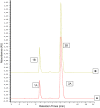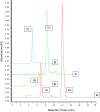Assessment of the Quality of Injectable Antibiotics in Benin
- PMID: 35895356
- PMCID: PMC9294693
- DOI: 10.4269/ajtmh.21-0844
Assessment of the Quality of Injectable Antibiotics in Benin
Abstract
Substandard and falsified medicines are an enormous threat to global health. Poor quality antibiotic preparations contribute to the development of antimicrobial resistance. In surgery, where the occurrence of healthcare-associated infections is high, healthcare teams need to rely on the quality of antibiotic prophylaxis to prevent infections. We assessed the quality of antibiotics used for surgical infection prophylaxis in Benin. Thirty-three samples were collected from six hospitals located in various departments in Benin. The antibiotics (powders for injection: amoxicillin + clavulanic acid, ampicillin, ceftriaxone; solutions for injection: ciprofloxacin, gentamicin, metronidazole) were assessed using visual inspection, pharmacotechnical tests (including uniformity of mass, pH measure, sterility test, and active pharmaceutical ingredient identification), and assay tests (including a simple analytical method thin layer chromatography) and complex analytical techniques (ultraviolet-visible spectrophotometry, high-performance liquid chromatography-diode-array detection, conductometry). Because the material needed for the methods recommended by the pharmacopeias to assess the dosage of gentamicin was not available, we developed and validated a conductometry method. Results showed that 97% (n = 32) of the samples passed visual inspection; 100% (n = 33) of the samples passed the pharmacotechnical tests, identification of active ingredients, and sterility test; 88% (n = 29) passed the test for percentage of active pharmaceutical ingredients. Overall, 15% of the samples did not pass the quality test (3% on visual inspection and 12% for excess active ingredients). Although most of the samples passed the quality tests, it appears important to perform routine quality control for intravenous medicines.
Figures



References
-
- WHO , 2011. The World Medicines Situation 2011. Medicines Prices, Availability and Affordability. Geneva, Switzerland: World Health Organization. Available at: https://www.who.int/medicines/areas/policy/world_medicines_situation/WMS....
-
- WHO , 2017. Global Surveillance and Monitoring System for Substandard and Falsifed Medical Products. Geneva, Switzerland: World Health Organization. Available at: https://www.who.int/publications/i/item/WHO-MVP-EMP-SAV-2019.04.
-
- Delepierre A, Gayot A, Carpentier A, 2012. Update on counterfeit antibiotics worldwide; public health risks. Med Mal Infect 42: 247–255. - PubMed
-
- Ebrahim GJ, 1993. The Bamako initiative. J Trop Pediatr 39: 66–67. - PubMed
Publication types
MeSH terms
Substances
LinkOut - more resources
Full Text Sources
Medical
Molecular Biology Databases

